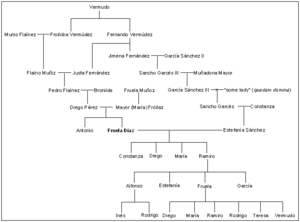Froila Ramírez

Froila or Fruela Ramírez (fl. 1150–1202) was a Leonese nobleman and a scion of the Flagínez clan. His power and influence lay chiefly in the heart of the province of León and its west, but it extended into Galicia and the Asturias.
Private activity
Froila was the second son of Ramiro Fróilaz and his first wife, Inés (Agnes). He is first mentioned in a document dated 22 September 1150, whereby his father granted to him and his elder brother, Alfonso, the bridewealth he owed to their late mother.[1]
He took his first wife, Urraca González, daughter of Gonzalo Fernández de Traba, sometime before 28 September 1171. He had been raised at the court of her grandfather, Fernando Pérez. On 29 June 1170, with no mention of their marriage, Froila granted the abbey of Morás to Urraca "out of love for your grandfather, Count Don Fernando, who raised me, and because of faithful service when I was accepted by your father, Count Don Gonzalo".[2] Later in 1171, after their marriage, she donated some property at Revello near Villalón to the Order of Santiago.[3] In 1173 Froila and Urraca granted their property at San Miguel de Camino (Sancti Michaelis de Camino) and at Val de Mazana (Valdemanzanas) to the Hospital of San Marcos.[4] Urraca supported the Hospitallers with a gift in 1182, and patronised the monasteries of Benevívere and Meira in 1189. She died on 1 August 1190. By May 1198 Froila had remarried to a woman named Sancha Fernández.[5] She is a very obscure woman, who was still living in 1234, when she donated land at Fresnedo to the monastery of Vega de Espinareda. Froila's known children, all with Sancha, were Diego, María, Ramiro, Rodrigo, Teresa, Vermudo (Bernardo), and perhaps a Nuño.
Froila's religious patronage was diverse. He made early grants to the Cathedral of Santa María in León (1174) and the Benedictine monastery at Sahagún (1175). He endowed the Hospitallers in 1181 and 1184, by which time his wife had already shown partiality to the military orders.[6] In 1188 he made a grant to the Cistercian house of Peñamayor.
Public activity
The first tenencia (fief from the crown) which Froila received was Castrotierra in 1168. In 1171 he was given the government of Astorga, which his grandfather Froila Díaz had ruled. This tenencia held limited powers in the city of Astorga itself but rather more in the surrounding region (terra). In 1173 he held briefly the tenencia of Villamor. Between 1182 and 1184 he served Ferdinand II as alférez, overseeing the royal military entourage, a post usually reserved for young noblemen at court. In 1186 he was appointed to the vast tenencia of Asturias de Oviedo, where his family's origins lay. He was reappointed to govern it five times: in 1187, 1189, 1192, 1193, and 1195. In the same year (1186) that he first received Oviedo he was also appointed to govern the Bierzo in western León. It was to be the centre of his power after the loss of Astorga and he held it until 1198 with a brief interlude (April 1188–May 1189), when it was held by Velasco Fernández.
Upon losing Astorga in 1188, on the death of Ferdinand II, Froila was recompensed with the tenencias of Mayorga, Montenegro, and Sarria. By 11 August 1189 he bore the title count (Latin comes), the highest in the kingdom. The lands he governed for the crown were rapidly expanded in the early years of Alfonso IX. In 1189 he received the rule of Asturias de Tineo (retained until 1192), Babia, Faro, Lemos, Monreal, Riba de Esla, and Villafranca (retained until 1194). Between 1190 and 1192 he was transferred to the tenencias of Ulver and Valcárcel.
In 1191 Froila was granted the tenencia of León, the royal capital, a post which, though largely honorific, had been held by his grandfather before him. On 9 April 1192 he received Salientes from Alfonso IX pro bono seruicio ("for good service"). In subsequent years he ruled the tenencias of Béjar (1192), Almanza (1193), Valle (1194), and Toro (1197). In May 1198 Froila and Sancha ceded a fuero to the town of Cifuentes de Rueda, which had been in his family for generations.[7]
Notes
- ↑ Barton, 54. The original document from Santa María de Oteros de las Dueñas, where Froila's familial archives were kept, is transcribed and edited in Barton, 313, where Froila's name is given as Froile Ramiri and later Froala Ramiri.
- ↑ The original Latin reads: propter amore auu uestri comitis domni Fernandi qui me creauit, et propter seruicium fidelem quem accepi a patre uestro comite domno Gundisaluo, cf. Barton, 247.
- ↑ José Luis Martín Rodríguez, "Fernando II de León y la Orden de Santiago (1170–1181)", Anuario de estudios medievales, 1 (1964), 188.
- ↑ Martín Rodríguez, 189 and 191.
- ↑ Her patronymic is found in Esther Pascua Echegaray, "Hacia la formación política de la monarquía medieval: las relaciones entre la monarquía y la iglesia castellanoleonesa en el reinado de Alfonso VII", Hispania, 49:172 (1989), 441.
- ↑ For details of these donations, cf. Santos García Larragueta, "La Orden de San Juan en la crisis del Imperio Hispánico del siglo XII", Hispania, 12:49 (1952), 512–13.
- ↑ Barton, 108 n26. For a table of twelfth-century aristocratic fueros, cf. Barton, 96.
References
- This article is based on Simon Barton (1997), The Aristocracy in Twelfth-century León and Castile (Cambridge: Cambridge University Press), especially pp. 247–48, which contain a brief curriculum vitae.
- There is a brief genealogical notice at the Medieval Lands Project website.